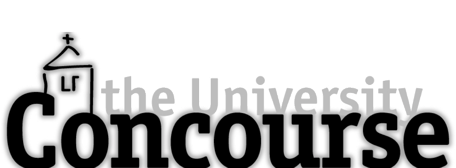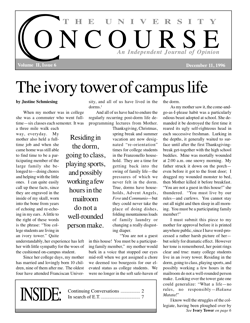Can E.T.‘s be? Do they fit in with the O.T. and the N.T.?
by John R. Holmes
The first time I taught science fiction at Franciscan University (a decade ago), a prospective student timidly, yet bluntly, asked me: “Is science fiction pagan?” I was so stunned by the question that I don’t think I gave a very good answer, but it boiled down to “No.” I was not convincing. The student did not take the course.
But what could he have meant? I think that an inkling of the orthodox Catholic’s difficulty with science fiction can be gained from Justine Schmiesing’s delightful essay, in the November 20 Concourse, on the doctrinal implications of life on other planets. My response here is offered not so much as a rebuttal to one of my favorite students, but as a plea to the readers of the Concourse to take this question seriously, for it has implications for Catholic attitudes not only toward science, but also toward science fiction.
First off, as a gesture of good will, I am going to offer Mrs. Schmiesing some heavy ammunition for her argument. In fact, I was surprised at its absence in her essay: it is often the first scriptural reference in this debate among Christian science-fiction fans. It is the elementary truth that God made us in his own image and likeness. It is implied by her reflections on the incarnation, but let’s consider the E.T. implications of this specific phrase: the image and likeness of God. Wouldn’t it privilege us (if I may, with the deconstructionists, verbize a noun) over any alien life form in the same way we are privileged over all earth life forms?
Actually, the deepening of our understanding of the Genesis phrase “dominion” in recent years, especially in the current pontificate, may offer an analogy to the other-worlds problem. For doctrine, as Newman pointed out, can develop without contradicting itself. Christianity itself is the result of such development, such widening of the understanding of earlier scripture and revelation. I pray that this discussion might prepare us intellectually, spiritually and theologically for a similar widening if we ever discover what I believe to be compatible with both scripture and Catholic tradition—intelligent life beyond earth.
The change in understanding of “dominion” is profound: it had often been mistakenly taken to mean “domination”—an assumption that other creatures exist only to serve us. This is a half-truth: while we are the pinnacle of creation, too selfish an understanding of our dominion can blind us to the dignity of all creatures in themselves. If you’re wondering where I’m getting this dangerously ecological language, it is from the Holy Father’s Peace Day message for 1990, “Peace with God the Creator, Peace with Creatures.”
So, if our understanding of so standard a scriptural term as “dominion” can grow and deepen, the same might happen to our understanding of our unique place in creation regarding life (if any) “in space.” I would rather not wait until the saucers land to study this question, either.
I’ll place the E.T. problem in a scenario least friendly to my position: an intelligent alien race is discovered which bears virtually no physical resemblance to us—picture them however you will. Yet they have art, poetry, love—all of the things we associate with “spirit” outside of the theological sense of the term. Can we assume these creatures have souls, and therefore are worthy of evangelization? Well, confronted by the phrase “image and likeness,” we might at first have to say, “no.” But what do we mean by “image”? Do we mean exclusively the physical image: head, torso, limbs and organs, as articulated in the people we know? If we mean that exclusively, then the single cell of a newly-fertilized human zygote is not fully human, does not bear the image and likeness of God. I have heard precisely that argument proposed, but somehow it did not ring true to me. Similarly, the “likeness” does not exclusively apply to physical likeness, though here we’re on safer ground, as Augustine distinguished the two words, suggesting that our “likeness” to God was broken by the sin of our first parents.
But if I am not granted the premise that “image and likeness” need not be physically literal—and I welcome theological correction here, as I am simply ignorant on this score—let’s pursue the same scenario with the assumption that only earthlings are made in God’s image. Does that preclude the E.T.s’ hope for eternal life and their need for evangelization? Again, salvation history parallels this scene: The O.T. covenant was very narrow, restricted to the Chosen People of God. The N.T. covenant went beyond the tribes of Israel, to all nations, and we are urged to bring the good news to them all. Is an E.T. covenant possible?
The same question was asked after the discovery of the Western Hemisphere. And here is where I respond to another aspect of Mrs. Schmiesing’s presentation: the argument from silence. Just as Scripture and tradition are silent on the issue of other worlds, they are silent on the existence of North and South America. And after 1492 there was much theological discussion of whether the natives of North America had souls and were therefore worthy of evangelization. Our question of whether E.T. had a soul might in the future look as silly as the question of Squanto or Massasoit having a soul looks today.
As for the real existence of Tolkien’s Middle Earth, and working out the Christological implications of C.S. Lewis’ Narnia, Mrs. Schmiesing is quite right: it “doesn’t work.” That is, it doesn’t work on the literal level. But neither, for Catholic doctrine, does that great work of imaginative truth we call “Genesis.”
The reason a liberal arts education includes theology and literature (and, I suspect, one reason that Mrs. S. was an English major), is that literature uses images (there’s that word again) to draw our mind out of the literalness of reason, as Keats puts it, to “tease our mind out of thought.” So, although the lion Aslan can help the young mind understand something of the majesty of Christ, still we certainly can’t take his existence literally. If we did, how could Jesus be both the Lamb of God and the Lion of Judah? There are, however, some images that Catholics do take literally where other Christians do not, such as a rewording of the preceding question: how can Jesus be both bread and flesh? But even there, the transcendent reality of transubstantiation teases us out of thought, or at least of the resources of language.
Before leaving C.S. Lewis, however, it ought to be said that he gave us other works of fiction that deal more directly with this problem of intelligent life on other worlds: the so-called “space trilogy” of novels: Out of the Silent Planet, Perelandra, and That Hideous Strength. In these novels we are presented with civilizations on both Mars and Venus which do not have our scriptures, but which do have a revelation from God which precisely corresponds with our own, and do share our salvation history: Mars has an older culture which never fell to temptation, and Venus a younger which has not yet been tempted.
I will close with two thoughts that I can’t develop fully in this space, for future discussion. One is a way to connect this issue with another current debate in the Concourse: the role of feminism in Catholic orthodoxy. Feminist science fiction critics (and writers) have utilized the analogy of the human race facing a radically different sentient race which Europeans experienced in discovering the new world. Yet they maintain that the experience is far older: it is seen in the male discovery (or in some cases the denial) of the rationality of women. Women are from Venus, and men are not only from Mars, but suffer from Venus Envy.
The second point is the extent to which, before Columbus, medieval philosophers, particularly Scotus, discussed the possibility of other worlds. The whole debate, even in its theological wrinkles, is older than we might think.
So please, dear Concourse readers: help me out. I see nothing in Scripture or in Catholic doctrine to deny or even to make unlikely the existence of life on other worlds. Am I missing something? O.T., N.T., Ph.D. and S.T.D., phone home.
Dr. Holmes is an Associate Professor of English at FUS.


